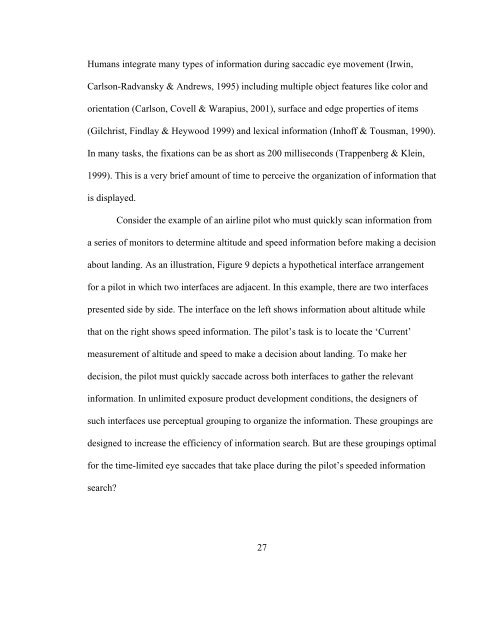The Use of Iambic Pentameter in the
The Use of Iambic Pentameter in the
The Use of Iambic Pentameter in the
You also want an ePaper? Increase the reach of your titles
YUMPU automatically turns print PDFs into web optimized ePapers that Google loves.
Humans <strong>in</strong>tegrate many types <strong>of</strong> <strong>in</strong>formation dur<strong>in</strong>g saccadic eye movement (Irw<strong>in</strong>,<br />
Carlson-Radvansky & Andrews, 1995) <strong>in</strong>clud<strong>in</strong>g multiple object features like color and<br />
orientation (Carlson, Covell & Warapius, 2001), surface and edge properties <strong>of</strong> items<br />
(Gilchrist, F<strong>in</strong>dlay & Heywood 1999) and lexical <strong>in</strong>formation (Inh<strong>of</strong>f & Tousman, 1990).<br />
In many tasks, <strong>the</strong> fixations can be as short as 200 milliseconds (Trappenberg & Kle<strong>in</strong>,<br />
1999). This is a very brief amount <strong>of</strong> time to perceive <strong>the</strong> organization <strong>of</strong> <strong>in</strong>formation that<br />
is displayed.<br />
Consider <strong>the</strong> example <strong>of</strong> an airl<strong>in</strong>e pilot who must quickly scan <strong>in</strong>formation from<br />
a series <strong>of</strong> monitors to determ<strong>in</strong>e altitude and speed <strong>in</strong>formation before mak<strong>in</strong>g a decision<br />
about land<strong>in</strong>g. As an illustration, Figure 9 depicts a hypo<strong>the</strong>tical <strong>in</strong>terface arrangement<br />
for a pilot <strong>in</strong> which two <strong>in</strong>terfaces are adjacent. In this example, <strong>the</strong>re are two <strong>in</strong>terfaces<br />
presented side by side. <strong>The</strong> <strong>in</strong>terface on <strong>the</strong> left shows <strong>in</strong>formation about altitude while<br />
that on <strong>the</strong> right shows speed <strong>in</strong>formation. <strong>The</strong> pilot’s task is to locate <strong>the</strong> ‘Current’<br />
measurement <strong>of</strong> altitude and speed to make a decision about land<strong>in</strong>g. To make her<br />
decision, <strong>the</strong> pilot must quickly saccade across both <strong>in</strong>terfaces to ga<strong>the</strong>r <strong>the</strong> relevant<br />
<strong>in</strong>formation. In unlimited exposure product development conditions, <strong>the</strong> designers <strong>of</strong><br />
such <strong>in</strong>terfaces use perceptual group<strong>in</strong>g to organize <strong>the</strong> <strong>in</strong>formation. <strong>The</strong>se group<strong>in</strong>gs are<br />
designed to <strong>in</strong>crease <strong>the</strong> efficiency <strong>of</strong> <strong>in</strong>formation search. But are <strong>the</strong>se group<strong>in</strong>gs optimal<br />
for <strong>the</strong> time-limited eye saccades that take place dur<strong>in</strong>g <strong>the</strong> pilot’s speeded <strong>in</strong>formation<br />
search?<br />
27

















